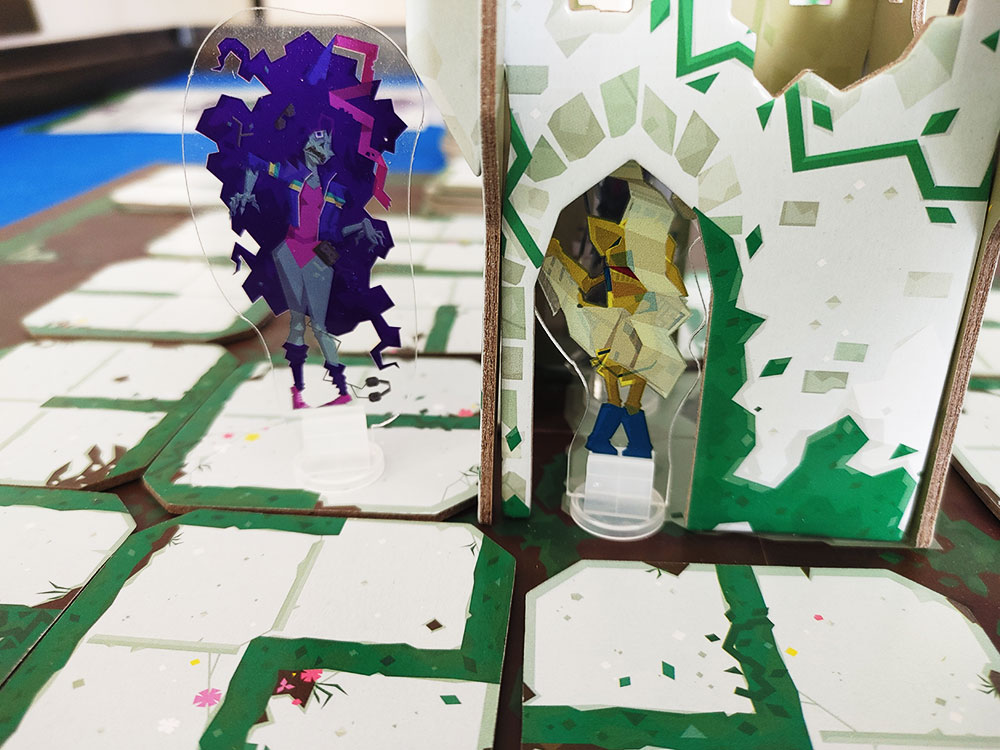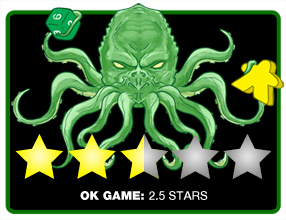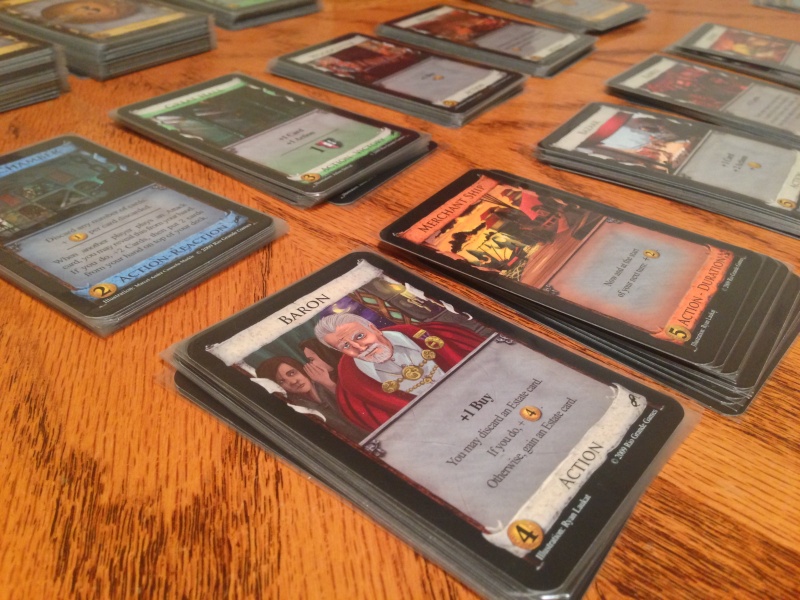 As one of Board Game Quest’s resident Euro aficionados, I’m always being offered games with the best and most interesting themes. Farming, mostly. Or tracking market prices along shipping routes. Sometimes it’s harvesting materials, but that kind of feels just like a type of farming so I’m not really sure it’s a separate thing. One time I was asked to review a game about trading herbs and spices at a vaguely medieval market, but I turned it down. Too unique for my blood.
As one of Board Game Quest’s resident Euro aficionados, I’m always being offered games with the best and most interesting themes. Farming, mostly. Or tracking market prices along shipping routes. Sometimes it’s harvesting materials, but that kind of feels just like a type of farming so I’m not really sure it’s a separate thing. One time I was asked to review a game about trading herbs and spices at a vaguely medieval market, but I turned it down. Too unique for my blood.
Needless to say, it was a shock to my system when Andrew Beardsley’s Zombie Princess and the Enchanted Maze landed at my desk. I opened it up and was horrified by what I saw. Where were my beige character pieces and nondescript wooden victory point marker? What about my supply of uniform, faceless meeples? Instead, the box was filled with oversized maze tiles inside and nifty-looking character standees. I was intrigued. Cautiously, I accepted the assignment.
Gameplay Overview:
The goal of Zombie Princess and the Enchanted Maze is for players to get their Knight to the opposite end of the board, retrieve a key, and then make it back to the central castle before the other players do. Or before they get turned into a zombie. So basically, it’s the same end game conditions as most other games. To achieve victory (and cheat death, as it were), players will collectively build and rearrange the titular maze, turn-by-turn, to either aid themselves or hinder their opponents.

At the start of each player’s turn, the active player will roll the Zombie Princess die. If they roll anything besides an “X,” they will move onto the Zombie Princess Phase. (Unrelated Note: Zombie Princess Phase is a great name for a band.) This phase entails adding a tile adjacent to the Zombie Princess, rotating any unoccupied tile or the central castle, and then moving the Zombie Princess a certain number of tiles depending on which number they rolled. These actions can be done in any order.
After this phase—whether the player activated the Zombie Princess or not—the active player will go through the Knight Phase. This is fairly like the Zombie Princess Phase except there’s no dice rolling. The player will add one of their tiles adjacent to their Knight, rotate an unoccupied tile or the castle, and move their Knight any number of spaces that aren’t obstructed. These actions are mandatory unless they’re impossible and can be done in any order.

(The rulebook really stresses that the Zombie Princess can move a certain number of tiles, not squares on the tiles, but the Knights can move any number of squares. As far as I can tell, this is a distinction without much of a difference. I can see the difference—the squares are smaller than the tiles, of course—but since moving along the squares is essentially always free on a turn, I struggled to understand why this distinction mattered.)
As the game progresses, the Zombie Princess might bump into Knights on their journey, whether by tactical positioning of the board by other players or because of their own poor planning. If this happens, the Knight in question joins the legion of the undead—“is turned into a Zombie Knight,” according to the game description—and now have a different set of rules. Basically, they no longer care about their key and move slower. They also can’t really win the game anymore unless all the other players become zombified. That means that everyone loses, so everyone wins. I guess? Does that make sense?
Otherwise, the first player to get their key to the castle at the center of the gameboard is the winner.

Game Experience:
Zombie Princess and the Enchanted Maze is a light game with straightforward design elements. It has some of the trappings of deeper tile-laying games but is exactly the game you think it is after a single play. This isn’t really a positive or negative, mind you, but those looking for strategic depth that blossoms over multiple plays can look elsewhere.
The game’s main differentiating mechanism is the inclusion of the titular Zombie Princess, who is controlled by all players throughout the game. At first, it’s a neat idea as players expand not only their own territory, but also the villain’s.

(I think the Zombie Princess is meant to be the game’s villain, but it’s certainly not clear. And this may or may not be relevant but this is my review so I can say what I want: I found it strange that in a game with a unique-if-pasted-on theme, none of the playable characters in the standard rules are women and the entire “princess wants to marry a knight” concept is basically lifted from a 1940s Disney film only with a slight zombie twist.)
Still, the overall design is really lacking. The concepts are very basic and a few of the mechanisms are so broad that they really bog down the flow of the game, especially in a family setting. (The ability to rotate basically any tile on the board each turn actually creates a ton of choices, many of which won’t even matter in games with a full complement of four players. And sometimes you can rotate two different tiles on a turn. The possibilities are endless!)

The mechanism where all players control the zombie and can chase the other players is probably the most interesting and yet least effective part of the game. It’s obviously fun to try to turn other players into zombies, but early in the game it doesn’t make any sense to create more zombies because then there will be more enemies to contend with. It makes more sense to turn others near the end of the game, but by that point everyone will be thinking the same thing, so it becomes a back-and-forth slog during which all the players are essentially undoing and redoing the same collection of moves.
Rolling a die to see if the Zombie Princess will even move every turn was already a questionable design choice, but this late-game scenario exacerbates the problem. At that stage of the game, a bad roll can drastically hinder someone’s chances of effectively attacking with the Zombie Princess or avoiding her. In truth, the die not only seems superfluous to the game’s design but also shouldn’t have included a face that completely prevents players from moving the princess.
Lastly, the components are an odd mixture of styles and usability. The character standees look cool but will not stay standing for more than a few seconds at a time. And the cardboard castle is not only unnecessary for gameplay, but it’s also an awkward obstruction that makes seeing paths on the opposite side of it impossible. In a game that’s meant to rely on route-building, that’s a major issue.
Final Thoughts:
I’ll admit that Zombie Princess and the Enchanted Maze is not meant for the type of gamer I consider myself to be. (Which is to say: A handsome, witty, and swashbuckling Euro gamer with a sharp mind and an even sharper fashion sense.) This is meant for families who want an entry-level tile placement endeavor.
The game was clearly designed to land in the “gateway minus” category just under something like Ticket to Ride, and for the most part, it succeeds in regards to rules overhead and the speed of player turns. There is also an “advanced play” mode that includes extra action tokens. I found this mode to be interesting but didn’t really like the random nature of how the tokens were distributed.
Final Score: 2.5 Stars – A light-hearted tile-laying game with a fun theme and straightforward mechanisms that’s a bit too one-dimensional even for family play.
 Hits:
Hits:
• Original theme
• Unique art
• Easy to grasp concepts
Misses:
• One dimensional gameplay
• The theme (i.e., zombie stuff) actually hurts the later stages of the game
• Doesn’t scale well at lower player counts
• The cardboard castle is simply an obstruction and serves no purpose
• Standees won’t stay standing






















